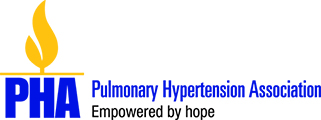Silver Spring, Md. (Apr. 21, 2016) – While the Pulmonary Hypertension Association (PHA) has seen marked progress in the treatment of pulmonary hypertension (PH) in its 25-year history, all things are not equal in the advancement of patient care. PHA has assembled 26 esteemed pulmonary hypertension (PH) specialists to launch PH Care for All to explore and address treatment disparities for minorities and low-income patients suffering from the life-threatening progressive lung disease.
PH is increased pressure in the blood vessels of the lungs that can lead to death from right heart failure. With symptoms that include shortness of breath, dizziness and fatigue, the disease is often misdiagnosed and treated as another illness, such as asthma. With early and accurate diagnosis, FDA-approved PH treatments can extend and improve the quality of life for many patients. This is essential. According to the National Institutes of Health (NIH) registry on pulmonary arterial hypertension (PAH), without treatment, median patient survival is only 2.8 years from the time of diagnosis.[1]
In 2011, analysis of the Registry to Evaluate Early and Long-term Pulmonary Arterial Hypertension (REVEAL) found that most PH patients experienced diagnostic delays culminating in a mean time to diagnosis of 2.8 years, with most patients receiving an accurate diagnosis only in the advanced stages of the disease.[2] Further, a recently published study by Dr. Arunabh Talwar and his colleagues indicates ethnic minorities and socioeconomically disadvantaged patients are impacted disproportionately by the most common barriers to PH diagnosis, as well as a number of additional barriers unique to these populations[3].
“These barriers not only adversely affect the PH diagnosis itself, but also impact patients’ ability to receive treatment once the diagnosis has been made,’ said Dr. Vinicio de Jesus Perez, of Stanford University who co-chairs PHA’s PH Care for All medical committee. “The concern is that many of these patients are missing the window for treatment and intervention entirely.”
A review of the National Center for Health Statistics database for the years 1994-1998 for death attributed to PAH [the form of PH for which the most treatments exist] by gender, age, and race over nine geographic regions revealed that African American women with PAH had the highest rates of mortality across all ages, [4] and these disparities are not isolated to the African American community. According to the 2010 US Census, approximately 36% of the population belongs to a racial or ethnic minority group and these numbers are projected to increase over the next decade. However, compared to the rest of the US population, many minorities experience reduced quality of life as a result of health-related problems[5]. The source of disparity is complex and appears to be related to socioeconomic status, limited education, higher genetic and environmental risks, greater barriers to health-care access and reduced adherence to established guidelines for prevention and treatment of acute and chronic conditions.
“With fourteen treatments—which is as many or more treatments that exist for all but two of roughly 7,000 rare diseases—PH patient care is growing rapidly,” said PHA President and CEO Rino Aldrighetti. “As PHA’s advocacy, education, awareness, Pulmonary Hypertension Care Center accreditation program, and the PHA Registry continue to improve PH diagnosis and care, we must ensure that the additional needs of underrepresented minorities and socioeconomically disadvantaged patients are met.”
Chaired by Dr. Vinicio de Jesus Perez of Stanford University and Dr. Anunabh Talwar of Northshore, Long Island Jewish Medical Center, PHA’s newest initiative, PH Care for All is seeking to level the field for these populations with the help of 26 expert clinicians and researchers in pulmonary hypertension committed to identifying and addressing barriers to pulmonary hypertension diagnosis and treatment encountered by minority and low income patients. The program’s medical leadership is engaging in new research through which they hope to identify specific barriers unique to underrepresented minorities and socioeconomically disadvantaged patients. PH Care for All will:
· Evaluate the impact of social and economic disparities within the United States, focusing on how these factors may impede access to PH care and lead to diagnostic delays;
· Identify populations at greatest risk of receiving inappropriate and inadequate PH care.
This research will ultimately inform advocacy work to ensure awareness of the needs of disadvantaged populations and to drive legislative change in favor of improved care for these populations, while also serving to drive institutional change within medical practice to remove barriers and improve access for these patients.
About the Pulmonary Hypertension Association
Headquartered in Silver Spring, Md., with a growing list of chapters across the country, the Pulmonary Hypertension Association (PHA) is the country’s leading pulmonary hypertension organization. Its mission is to extend and improve the lives of those affected by PH; its vision is a world without PH, empowered by hope. PHA achieves this by connecting and working together with the entire PH community of patients, families and medical professionals. Among its programs, PHA facilitates more than 245 support groups around the country and delivers continuing education for medical professionals through PHA Online University. For 12 consecutive years, PHA has received the highest rating — four stars — for fiscal accountability and transparency from Charity Navigator, placing it in the top half of one percent of all rated charities. For more information, please go to www.PHAssociation.org, @PHAssociation on Twitter or www.facebook.com/PulmonaryHypertensionAssociation.
[1] Rich S, et al. Ann Intern Med. 1987; 107: 216–223[2] Brown LM, et al. Chest 2011; 140(1): 19-26[3] Talwar A, Sahni S, Talwar A, Kohn N, Klinger, J. PC 2016. [Epub ahead of print] [4] Davis KK, Lilienfeld DE, Doyle RL. JAMA 2008;100:69-72[5] Beckles GL, Truman BI, Centers for Disease C, Prevention. Education and income – United States, 2009 and 2011. Morbidity and mortality weekly report Surveillance summaries 2013;62 Suppl 3:9-19
PRESS CONTACT:








